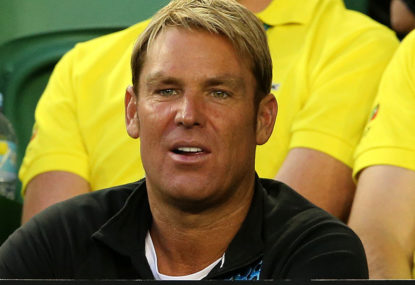Shane Warne last week announced his all-time Australian ODI side during the fourth Test against India at the SCG. I disagreed with several of his selections, which prompted me to name my own line-up.
Allan Border was, in my opinion, a better Test batsman than either Steve Waugh or Ricky Ponting. But he was a limited ODI batsmen in comparison to many that came after him so, sorry Warney, but he can’t get a gig in my side.
Greg Chappell certainly was not limited in 50-over cricket and, to my mind, is the only Australian Test batsman superior to Border apart, of course, from Sir Donald Bradman.
Did he do enough, however, in his comparatively brief ODI career to earn his place in Warne’s XI ahead of other batsmen who excelled over two or three times as many matches? Not quite, I believe.
Throughout his turbulent international career, Mitchell Johnson has always remained a potent ODI bowler, regardless of how badly he was spraying the red ball. He got the nod in Warne’s side but can’t find a place in mine.
Bizarrely, Warne omitted not just from his starting line-up but also from his list of five reserves arguably the greatest Australian ODI player of all time, Michael Bevan.
Here is my team and five reserves, followed by Warne’s choices:
My all-time Australian ODI team
1. M. Waugh (8500 runs at 39, with 18 centuries from 244 matches, plus 85 wickets at 35)
2. A. Gilchrist (9595 runs at 36, with 16 centuries from 286 matches)
3. R. Ponting (13589 at 42, with 29 centuries from 374 matches)
4. D. Jones (6068 runs at 45, with seven centuries from 164 matches)
5. M. Clarke (7762 runs at 45, with eight centuries from 238 matches, plus 56 wickets at 38)
6. M. Bevan (6912 runs at 54, with six hundreds from 232 matches)
7. A. Symonds (5088 runs at 40, with six hundreds from 198 matches, plus 133 wickets at 37).
8. B. Lee (380 wickets at 23, with 14 hauls of four wickets or more from 221 matches).
9. S. Warne (291 wickets at 26, with 12 hauls of four wickets or more from 221 matches).
10. D. Lillee (103 wickets at 21, with five hauls of four of more wickets from 63 matches).
11. G. McGrath (380 wickets at 22, with nine hauls of four of more wickets from 249 matches)
My reserves
1. S. Watson (5421 runs at 41, with nine centuries from 178 matches, plus 164 wickets at 31).
2. M. Hayden (6131 runs at 41, with ten centuries from 160 matches).
3. M. Hussey (5442 runs at 48, with three centuries from 185 matches).
4. S. Waugh (7569 runs at 33, with three centuries from 325 matches, plus 195 wickets at 35).
5. C. McDermott (203 wickets at 25 from 128 matches, with four hauls of four wickets or more).
Warne’s team: M. Waugh, A. Gilchrist, R. Ponting, G. Chappell, M. Clarke, A. Border, A. Symonds, M. Johnson, S. Warne, D. Lillee, G. McGrath. Warne’s reserves: M. Hayden, D. Jones, M. Hussey, G. Gilmour, B. Lee.
Adam Gilchrist was a straightforward choice to open the batting but I did ponder over his partner. Brutish left hander Matthew Hayden terrified opposition bowlers every bit as much as Gilchrist did.
It was Mark Waugh’s sublime fielding and handy off spin and medium pace that edged him ahead of Hayden. Ponting, like Gilchrist, needs no explanation at first drop.
Dean Jones, along with Michael Bevan, were the omissions from Warne’s side I found most surprising. Jones was a trailblazer in Australian ODI cricket, looking to dominate attacks when others were content to nudge around at four runs per over.
He also led the way with his hyper-aggressive running between wickets which saw later Australian sides become the best in the world at putting fieldsmen under pressure.
Clarke’s position at five in my side is likely to cause some conjecture, such are the varied sentiments towards Australia’s Test and ODI skipper. There were several others who would not look out of place in his spot, most notably Chappell and his former teammate Mike Hussey.
But Clarke’s lack of input in coloured clothing over recent years – the result of his frail body – should not distract from his immense achievements. Among the other top 30 runscorers in ODI history, only one player has a higher career average than Clarke – Indian skipper MS Dhoni.
Together with his remarkable fielding and useful bowling, Clarke at his peak was an invaluable player.
Behind Clarke at six is Bevan, who I until now assumed was an automatic inclusion in everyone’s all-time Australian ODI team.
Not in Warne’s though. Only Ponting and Gilchrist could challenge Bevan for the title of his country’s greatest-ever 50-over player.
I considered including Watson as the side’s chief all-rounder at the expense of Andrew Symonds but realised such a selection would ensure another day of Roar debate centred around Australia’s most controversial player.
Symonds was no better with the bat than Watson, and a far lesser bowler, but his fielding was vastly superior and he is also more suited to batting at seven than Watson whose success has come at the top of the order.
Warne and Glenn McGrath are givens in any Australian ODI attack. Brett Lee, though, arguably had a 50-over career the equal of either of those legends.
Similar to Johnson, Lee had an inconsistent Test career but was wonderfully reliable and destructive in coloured clothing.
His ability to hoop the white ball late at more than 150km/h was too much for many opposition batsmen. I’d offer him the chance to share the new ball with his country’s supreme quick, Dennis Lillee.
So, what do you reckon Roarers – did Warne hit the mark, or was my team better? What would yours be?





























































































